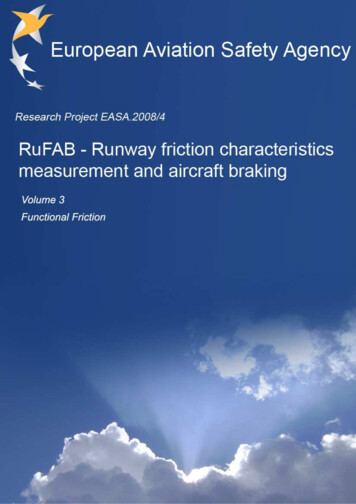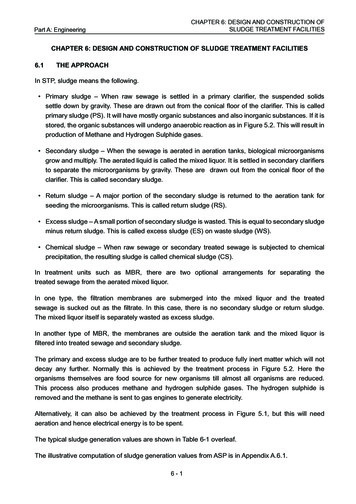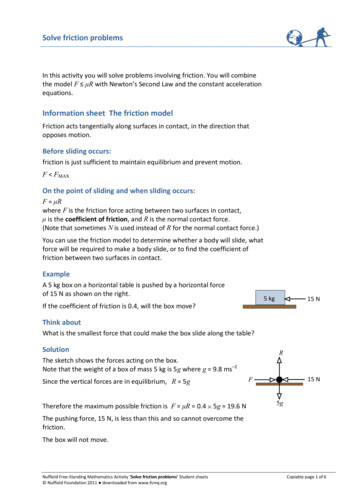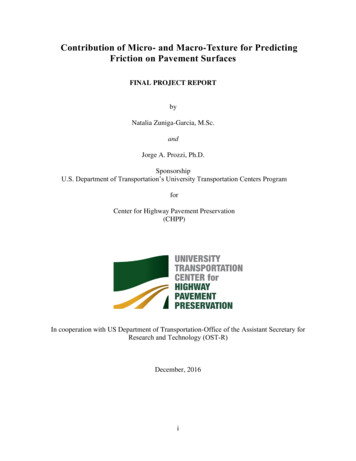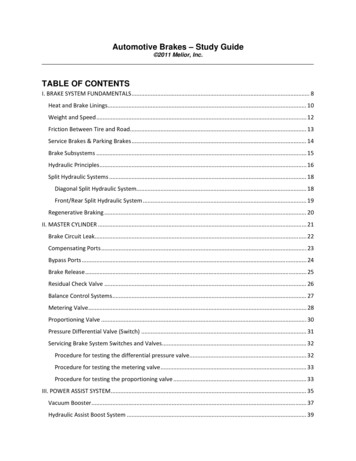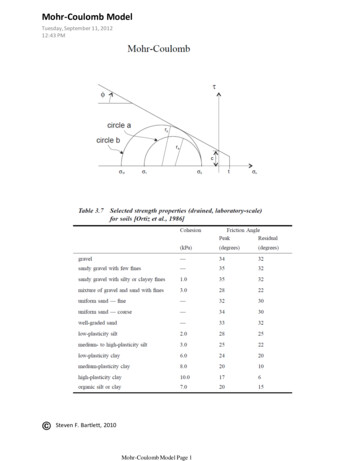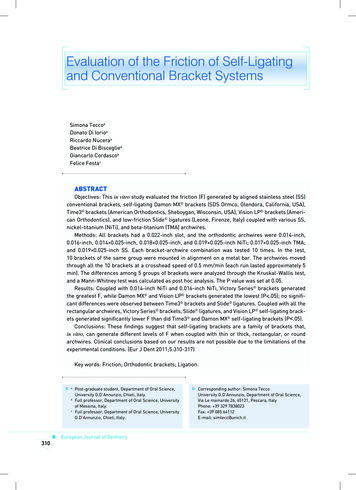
Transcription
Evaluation of the Friction of Self-Ligatingand Conventional Bracket SystemsSimona TeccoaDonato Di IorioaRiccardo NuceraaBeatrice Di BisceglieaGiancarlo CordascobFelice FestacAbstractObjectives: This in vitro study evaluated the friction (F) generated by aligned stainless steel (SS)conventional brackets, self-ligating Damon MX brackets (SDS Ormco, Glendora, California, USA),Time3 brackets (American Orthodontics, Sheboygan, Wisconsin, USA), Vision LP brackets (American Orthodontics), and low-friction Slide ligatures (Leone, Firenze, Italy) coupled with various SS,nickel-titanium (NiTi), and beta-titanium (TMA) archwires.Methods: All brackets had a 0.022-inch slot, and the orthodontic archwires were 0.014-inch,0.016-inch, 0.014 0.025-inch, 0.018 0.025-inch, and 0.019 0.025-inch NiTi; 0.017 0.025-inch TMA;and 0.019 0.025-inch SS. Each bracket-archwire combination was tested 10 times. In the test,10 brackets of the same group were mounted in alignment on a metal bar. The archwires movedthrough all the 10 brackets at a crosshead speed of 0.5 mm/min (each run lasted approximately 5min). The differences among 5 groups of brackets were analyzed through the Kruskal-Wallis test,and a Mann-Whitney test was calculated as post hoc analysis. The P value was set at 0.05.Results: Coupled with 0.014-inch NiTi and 0.016-inch NiTi, Victory Series brackets generatedthe greatest F, while Damon MX and Vision LP brackets generated the lowest (P .05); no significant differences were observed between Time3 brackets and Slide ligatures. Coupled with all therectangular archwires, Victory Series brackets, Slide ligatures, and Vision LP self-ligating brackets generated significantly lower F than did Time3 and Damon MX self-ligating brackets (P .05).Conclusions: These findings suggest that self-ligating brackets are a family of brackets that,in vitro, can generate different levels of F when coupled with thin or thick, rectangular, or roundarchwires. Clinical conclusions based on our results are not possible due to the limitations of theexperimental conditions. (Eur J Dent 2011;5:310-317)Key words: Friction; Orthodontic brackets; Ligation.abcPost-graduate student, Department of Oral Science,University G.D’Annunzio, Chieti, Italy.Full professor, Department of Oral Science, Universityof Messina, Italy.Full professor, Department of Oral Science, UniversityG.D’Annunzio, Chieti, Italy.European Journal of Dentistry310Corresponding author: Simona TeccoUniversity G.D’Annunzio, Department of Oral Science,Via Le mainarde 26, 65121, Pescara, ItalyPhone: 39 329 7838023Fax: 39 085 64112E-mail: simtecc@unich.it
Tecco, Di lorio, Nucera, Bisceglie, CordascoIntroductionIn orthodontics, several studies have showedthat bracket and wire materials, sections, surfaceconditions, type and force of ligation, use of selfligating brackets, saliva, and other oral functionsinfluence friction (F) at the archwire-slot interface.1-10Self-ligating bracket11-12 is a family of ligatureless brackets characterized by a metal device toclose off the edgewise slot2 that demonstrates asignificant decrease in F compared to conventional brackets.7,10,13-18Recently, new low-friction systems and selfligating brackets were introduced in trading, withdifferentiated performances according to theirmanufacturers.Among them, for example, there are low-friction ligatures (Slide ; Leone, Firenze, Italy), whichare similar to conventional elastic ligatures, buthave an anterior part that is more rigid and similarto the cap of self-ligating brackets; they are recommended when low F is desired, but they can bereplaced when more F is needed. Then, there arealso the recently introduced Vision LP brackets(American Orthodontics, Sheboygan, Wisconsin,USA), which seem to generate low F even whenthick rectangular archwires are employed. Onthe contrary, there are other recently introducedbrackets, called Time3 brackets (American Orthodontics), which guarantee high F with thickrectangular archwires in order to better controldental torque.According to the proper manufacturers, eachof these brackets has different clinical indicationsand can be helpful in various situations in whichdifferent levels of F are needed. However, the literature lacks comparisons about F generated bythe brackets. Thus, the aim of this in vitro studyis to compare the F generated by these recentlyintroduced self-ligating brackets, low-frictionligatures, and conventional stainless steel (SS)brackets.The null hypothesis for this investigation wasthat there are no significant differences amongthe various self-ligating brackets and betweenthe low-friction system and traditional system, interms of F generated, when these brackets arecoupled with the same type of archwire.MATERIALS AND METHODSMechanical testingIn this investigation, we included passive, interactive, and conventional brackets, according tothe classification introduced in literature by Voudouris.19The brackets tested were:(1) Damon MX brackets (SDS Ormco, Glendora, California, USA) (passive),(2) Time3 brackets (American Orthodontics)(interactive),(3) Victory Series brackets (3M Unitek, Monrovia, California, USA) ligated with Ligature Ringlet elastic modules (RMO, Denver, Colorado,USA) (traditional),(4) Victory Series brackets (3M Unitek) ligatedwith Slide low-friction ligatures (Leone) (conventional), and(5) Vision LP brackets (American Orthodontics) (passive).The testing model (fabricated by Myrmex Laboratory, Foggia, Italy) was described in a previousinvestigation.9 It was composed of a metal bar,approximately 10 cm long, 3.5 cm wide, and 1 cmthick. On one of the larger surfaces of this metalbar, 10 brackets (to represent the upper right tothe upper left second bicuspid) were bonded by thesame technician, Mr. Ugo Comparelli. Ten brackets of the same group were mounted in alignmenton the metal bar using a cyanoacrylate adhesive(Loctite 416; Loctite Corp., Rocky Hill, Connecticut, USA). The number of procedures was calculated using a test for the calculation of samplenumerosity on the basis of α value fixed at 0.05,considering the minimum detectable differenceand the number of groups.Alignment of the brackets was obtainedthrough preliminary insertion of a 0.021 0.028inch SS archwire into the slots of the brackets,without ligation. However, as minor misalignments of the brackets or non-linearity of the wirecould not be controlled to estimate the extent towhich the F could be attributed to misalignmentrather than ligation, a preliminary confirmatorycheck was performed by measuring F for eachbracket-archwire combination with only the terminal brackets ligated.The models with only the terminal brackets ligated were compared with each other, and then,with the models with all the brackets ligated. Thecomparison among models with only the terminalbrackets ligated is useful because if the comparison was among different types of brackets (withthe same slot size) coupled with the same archwire but without any ligation except for the terminal brackets (ligated in order to obtain only thestabilization of the archwire along the slots), noJuly 2011 - Vol.5European Journal of Dentistry311
Friction of self-ligating systemsdifferences would be observed among the brackets in terms of F, except if the brackets (of 1 type,with respect to another) were positioned in misalignments. In this case, the expectation is that the10 misaligned brackets could generate a higher Fwith respect to the 10 brackets positioned in alignment.In total, 25 testing models were constructed,i.e., 5 models for each group of brackets (VictorySeries , Time3 , Damon MX , Slide ligatures,and Vision LP ). For each group, a single modelwas used 10 times to test the same bracket-archwire combination with all the brackets ligated and10 times to test the same bracket-archwire combination with only the terminal brackets ligated.The archwires tested were 0.014-inch,0.016-inch, 0.014 0.025-inch, 0.018 0.025-inch,and 0.019 0.025-inch nickel-titanium (NiTi);0.017 0.025-inch beta-titanium (TMA); and0.019 0.025-inch SS (Table 1).For each testing procedure, a new archwire wasemployed. The F values were evaluated for eacharchwire 10 times. The tests were run in dry stateat an ambient temperature of 34 C maintainedthrough the use of an air conditioner. For frictionalevaluation, a mechanical testing machine (ModelLloyd 30K; Lloyd Instruments Ltd., Segensworth,UK) with a 10-lb tension load cell, set at a range of1 lb and calibrated from 0 to 1000 g, was employed.The archwires moved through all the 10 bracketsat a crosshead speed of 0.5 mm/min (each runlasted approximately 5 min). F was calculated asthe mean of all the values recorded as the wirewas drawn through the brackets. F was calculatedin centiNewtons (cNs). A randomized sequencefor each type of archwire was performed. The loadcell registered the force levels needed to move thewire along the 10 aligned brackets, and these levels were transmitted to a computer.Statistical analysisDescriptive statistics were calculated for eachbracket-archwire combination. Due to skeweddata, nonparametric tests were used to investigatestatistically significant differences in F among thegroups. The data were analyzed as differences inF observed in the groups of archwires among the5 groups of brackets with all the brackets ligatedthrough the Kruskal-Wallis test; if the results ofthe Kruskal-Wallis test were significant, a MannWhitney test was performed as post hoc analysis to evaluate the significance of the differencesamong the groups.In order to estimate the extent to which Fcould be attributed to the misalignment of brackets rather than to the type of ligation, a statisticalcomparison (Kruskal-Wallis test) was also performed on all the groups of brackets with only theterminal brackets ligated.Finally, a Mann-Whitney test was performedon the data for all ligated brackets and the datafor those with only the terminal brackets ligated;comparisons were made for each bracket-archwire combination in order to verify the effect of ligation on F. For each statistical test, the statisticalsignificance was set at α 0.05.RESULTSFor majority of the bracket-archwire combinations, F values obtained with all the 10 brackets ligated were significantly higher than thoseobtained with only the terminal brackets ligated;no significant differences were observed in only 4cases, i.e., when the Damon MX brackets and Vision LP brackets were engaged with round archwires (Table 2).The F recorded with all the brackets ligatedand their significant differences are shown in Table 2 and Figure 1. Coupled with round archwires,Damon MX and Vision LP brackets generatedTable 1. Self-ligating, conventional brackets and archwires used in the study.Self ligating and conventional bracketsaDamon MX, SDS OrmcoTime3, American OrthodonticsVictory, 3M Unitek with elastic ligaturesVictory, 3M Unitek with slide ligatures (Leone)Vision LP, American OrthodonticsaBracket had nominal slot dimension of 0.022 inch.bArchwires obtained directly from the manufacturers.cNickel-titanium in the austenitic phase.dRMO, Denver, Colorado, USA.eDentaurum, Pforzheim, Germany.European Journal of Dentistry312Archwireb nominal dimensions and alloy0.014 NiTi-A c d0.016 NiTi-A c d0.014 x 0.025 NiTi-A c d0.018 x 0.025 NiTi-A c d0.017 x 0.025 TMA e0.019 x 0.025 NiTi-A c d0.019 x 0.025 Stainless Steel e
Tecco, Di lorio, Nucera, Bisceglie, Cordascosignificantly lower F than Victory Series , Time3 ,and Slide ligatures brackets (P .05). Victory Series brackets generated significantly higher Fthan the other groups (P .05). Coupled with rectangular archwires, Victory Series , Slide ligatures, and Vision LP self-ligating brackets gener-ated significantly lower F than Time3 and DamonMX brackets (P .05).DISCUSSIONIn this investigation, we made a comparisonof the effects of different self-ligating and con-Figure 1 Descriptive statistics of force. * indicates statistically significant differences among the 5 groups (P .05).Table 2. Friction recorded for each bracket-archwire combination, with 10 brackets ligated and with only terminal brackets ligated. The statistically significant differences wereevaluated as intra-group differences and among the five types of brackets for each archwire, when all the brackets were ligated and when only terminal brackets were ligated.The ** represents the significant inter-group differences. See the legends for details.Victory SeriesTime310 brackets ligatedMeanSD10 brackets ligatedMeanSDDamon MXSlide ligaturesVision LP10 brackets ligated10 brackets ligated10 brackets ligatedMeanSDMeanSDMeanSD0.014 NiTi§ 751.4**152.5504202.4‡ 53**12452150‡ 51**120.016 NiTi§ 800,2**151.4554253.6‡ 48**16.4581230‡ 49.2**11.70.014 x 0.025 .30.018 x 0.025 790.017 x 0.025 0.019 x 0.025 .019 x 0.025 nly terminalbrackets ligated0.014 NiTiOnly terminalbrackets ligatedOnly terminalbrackets ligatedOnly terminalbrackets ligatedOnly terminalbrackets ligatedMeanSDMeanSDMeanSDMeanSDMeanSD522051.22251 NS11522152 NS11.30.016 NiTi54.423532352.4 NS16512251 NS10.40.014 x 0.025 NiTi60.5188422.881.21852.3295818.20.018 x 0.025 NiTi78.433.512333101.319791882.4210.017 x 0.025 TMA218.452.620358302491975297.3280.019 x 0.025 SS158.258.62519220181.615328.2151.4310.019 x 0.025 NiTi220.493.725477.8302.1122.3198.279.3198.238** p 0.05‡ When coupled with round archwires, Damon MX and Vision LP showed a significant lower F than Victory Serie, Time 3 and Slide Ligature§ When coupled with round archwires, Victory Series showed a significant higher F than all the other groupsΦ When coupled with rectangular archwires, Time 3 and Damon MX showed a significant higher F than all the other groupsNS In the comparison between the same brackets in the two conditions (with all the brackets ligated and with only the terminal brackets ligated), Damon MX and Vision LPshowed no significant difference between the two conditions, when coupled with round archwires.July 2011 - Vol.5European Journal of Dentistry313
Friction of self-ligating systemsventional brackets on F, but we did not include agroup ligated with SS ligature wire to avoid unexpected results associated to the force spent by theoperator during ligation.In addition, because of its design, this in vitrostudy cannot add data on the clinical indications ofthese brackets. However, the results will be useful to indicate the proper clinical study that mustbe conducted to obtain such data. Then, clinicalconclusions are not possible due to the limitationsof the experimental conditions, as, for example, itdid not take into account the canine bracket tipping during retraction or the undesirable rotationduring retraction.As reported in Table 2, for majority of bracketarchwire combinations, the F values obtained withall 10 brackets ligated were significantly higherthan those recorded with only the terminal brackets ligated (P .05), confirming that ligation playsan important role in generating F. This is in accordance with previous literature.14,20There were no significant differences in only 4cases, i.e., when Damon MX and Vision LP brackets were engaged with round archwires, probablydue to the shapes of their rigid caps. As reported,the archwires were moved at a crosshead speed of0.5 mm/min (each run lasted approximately 5 min)to avoid failure of the brackets from the metalbar. This low crosshead speed is generally lowerthan in other investigations, such as, for example,Khambay et al,7 who used a crosshead speed of 5mm/min (each test run lasted for 4 min) but included only 1 bracket in their model.In this study, 3 different self-ligating brackets showed different trends when used with thevarious archwires (Table 2 and Figure 1). Coupledwith round archwires (0.014-inch and 0.016-inchNiTi archwires), Time3 self-ligating bracketsgenerated significantly higher F than the other 3self-ligating brackets (Damon MX and Vision LP brackets), while no significant differences wereobserved between Slide ligatures and Time3 brackets. On the contrary, Victory Series generated significantly higher F than all the othergroups (Table 2 and Figure 1). A consistent agreement was found among the reviewed studies thatself-ligating brackets produce lower F comparedto conventional brackets when coupled with smallround archwires, as pointed by a recent systematic review.21 The differences in F observed amongthe self-ligating brackets could be explained bythe differences in the shapes of their little caps.Damon MX and Vision LP brackets show a littleEuropean Journal of Dentistry314cap that keeps the bracket closed without pressing the archwire against the slot, while the Time3 bracket is characterized by a bell-shaped cap thatcan squeeze the archwire into the slot, probablyincreasing F at the archwire-slot interface.As noted, Damon MX and Vision LP bracketsshowed a lower level of F with round archwirescompared to the other groups, suggesting thatamong the archwire-bracket combinations considered, they could guarantee the lowest F duringthe alignment phase of orthodontic treatment.In addition, it must be noted that when coupledwith all the rectangular archwires, Damon MX brackets showed significantly higher F than majority of the other brackets (Table 2 and Figure 1), except for Time3 brackets, for which no significantdifferences were observed between the 2 systems(Table 2 and Figure 1). This finding suggests thatDamon MX bracket results in low F only whenengaged with round archwires but not with rectangular archwires, probably because of the shapeof its sliding little cap, which when engaged withrectangular archwires, provides a large contactsurface between the archwire and slot walls, thusincreasing the level of F. Similarly, when coupledwith rectangular archwires, Time3 bracket couldprobably allow for an increase in F because of itsbell-shaped cap, which when closed, can compress the archwire against the slot walls.Vision LP brackets exhibited a different behavior with respect to the other 2 self-ligatingbrackets, showing a low F when matched witheither round or rectangular archwires (Table 2and Figure 1). Coupled with round archwires, Vision LP brackets showed significantly lower Fthan Victory Series , Slide ligatures, and Time3 brackets, but no significant differences with Damon MX brackets; as previously mentioned, thisfinding could be explained through the little capof this bracket, which could prevent the compression of the archwire against the slot, thus reducing the F generated, as is also assumed for DamonMX brackets. However, coupled with rectangulararchwires, Vision LP brackets showed significantly lower F than both, Damon MX and Time3 brackets (Table 2 and Figure 1), probably becausethe particular design of closing mechanism of thisbracket allows the little cap to slide along a railto maintain space between the archwires and slotwalls, thus reducing the F produced. In addition,the little cap of Vision LP brackets is not exactly on a parallel plane to the base of the slot, butis lightly inclined to leave a small trilateral free
Tecco, Di lorio, Nucera, Bisceglie, Cordascospace between the archwire and the little cap.Consequently, this little cap seems to allow for adecrease in F at the archwire-slot interface.Taken together, these findings suggest the importance of the closing mechanism and cap designin determining the F generated at the bracketarchwire interface. Differences in the structuraldesign and material composition of the bracketslot and cap can influence the level of F generatedat the bracket-archwire interface when coupledwith rectangular or round archwires.We must state that the particular design of thisstudy allowed a possible lack of alignment of the10 brackets, which presents as a limitation of thestudy. In passive systems, such as Damon MX andVision LP brackets, any rigid lack of alignmentwill lead to high levels of binding with rectangularwires, while in active systems and conventional ligated systems, the “give” in the ligation methodwill allow for a lack of alignment. In this regard,our findings are also a function of the experimental setup and do not actually reflect the situationin clinical use wherein the periodontal ligamentprovides “give.” This clarification is fundamentalas this concept limits the possibility of making anyclinical extrapolation from this study. This pointhas enormous importance from a clinical point ofview, because the clinician must know the different in vitro behaviors of the different self-ligatingbrackets.From a clinical point of view, for example, thelow F observed with Slide ligatures or Vision LP brackets, compared to Time3 and Damon MX brackets when coupled with rectangular archwires (Table 2 and Figure 1), could be consideredeither as an advantage or a disadvantage in different situations; during anterior tooth retraction,low F is desired in the lateral segment of dentalarches, while in the final phase of stabilization,high F is desired in all slots. For Slide ligatures,however, the primary advantage seems to be thatthey can be used only when low F is necessary orvice versa.From a clinical point of view, the observationsin this study altogether indicate that the clinicianmust select the type of self-ligating system to beemployed depending on the type of malocclusionto treat. With regard to the literature, our findingsabout Damon MX and Time3 brackets are in accord with those of Khambay et al,7 who employeda model with only 1 Damon SL II bracket and 1conventional straight-wire bracket, and tested (for10 times, in the presence of human saliva) variousarchwires with 4 types of elastomeric modulesand preformed 0.09-inch SS ligatures. They foundthat the Damon SL II (SDS Ormco, Glendora, California, USA) self-ligating bracket and unligatedconventional SS bracket produced negligible Fwith any of the round wires tested, but coupledwith 0.017 0.025-inch and 0.019 0.025-inch SSand 0.019 0.025-inch TMA archwires, the DamonSL II bracket produced the highest F (as in thisstudy), while the SS ligatures produced the lowest.As recently reported in a systematic review,there is not enough evidence to claim that withlarge rectangular wires, in the presence of tipping and/or torque and in arches with considerable malocclusion, SL brackets produce lower Fcompared to conventional brackets.21The primary finding of this study is that selfligating brackets with different slot designs showdifferent behaviors in terms of F generated at thebracket-archwire interface when coupled withrectangular or round archwires.In this study, Slide ligatures showed a similar behavior as the conventional ligatures whencoupled with all the rectangular archwires (Table2 and Figure 1). When coupled with round archwires, they showed significantly lower F than Victory Series and significantly higher F than DamonMX and Vision LP brackets, but similar F as theTime3 brackets. When coupled with rectangulararchwires, they showed significantly lower F thanDamon MX and Time3 brackets, but similar F asthe Vision LP brackets. This behavior is probablyassociated with their design; their elastic properties decrease when coupled with thicker archwires, resulting in low F. In contrast, self-ligatingbrackets have a built-in metal device (to close offthe edgewise slot) that is rigid and rather stiff,compared to the soft and elastic surface of lowfriction ligatures.Our findings are not in agreement with thegeneral statement that self-ligating bracketsgenerate lower F than conventional SS brackets,2,9,14-15,17-18,22 probably because a variety of different self-ligating brackets were tested, eachwith different mechanical characteristics:19 passive or interactive slots. The differences amongthe passive and interactive SL brackets could beexplained by the flexibility of the spring clip of active SL brackets that can actively engage the wirealso in the presence of tipping.21In addition, in this study, no significant differences were observed between the TMA, SS, andNiTi archwires in terms of F, although it was re-July 2011 - Vol.5European Journal of Dentistry315
Friction of self-ligating systemsported that TMA generates higher F than bothSS and NiTi for all bracket-archwire combinations.2,23-30 This variability may be due to the differences in the experimental setup, number ofbrackets, or bracket angulations.31 Therefore, adirect comparison of various published studies onthis topic is complex.One limitation of this study is that it was carriedout under ideal conditions, in a passive configuration with no misalignment of brackets, as shownby previous gating brackets appear to be a family ofvery different brackets.For majority of the bracket-archwire combinations, the F values obtained with all 10 brackets ligated were significantly higher than thoseobtained with only the terminal brackets ligated;no significant differences were observed in only4 cases, i.e., when Damon MX and Vision LP brackets were engaged with round archwires.Coupled with round archwires, Damon MX and Vision LP brackets generated significantlylower F than Victory Series , Time3 , and Slide ligature brackets, while Victory Series bracketsgenerated significantly higher F than all the othergroups. Coupled with rectangular archwires, Victory Series brackets, Slide ligatures, and VisionLP self-ligating brackets generated significantlylower F than Time3 and Damon MX brackets.However, as these findings do not actually reflectthe situation in clinical use wherein the periodontal ligament provides “give,” the possibility ofmaking any clinical extrapolation from this studyis limited.REFERENCES1. Besancon RM (Ed.) The encyclopedia of physics. 3rd edn.New York, NY: Van Nostrand Reinhold Company. 1985.2. Cacciafesta V, Sfondrini MF, Ricciardi A, Scribante A, KlersyC, Auricchio F. Evaluation of friction of stainless steel andesthetic self-ligating brackets in various bracket-archwirecombinations. Am J Orthod Dentofac Orthop 2003;124:395–402.3. Andreasen GF, Quevedo FR. Evaluation of frictional forcesin the 0.022 0.028 edgewise bracket in vitro. J Biomech1970;3:151–160.ramic brackets. J Clin Orthod 1996;30:78–84.6. Braun S, Bluestein M, Moore BK, Benson G. Friction in perspective. Am J Orthod Dentofac Orthop 1999;115:619–627.7. Khambay B, Millett D, McHugh S. Evaluation of methodsof archwire ligation on frictional resistance. Eur J Orthod2004;26:327–332.8. Khambay B, Millett D, McHugh S. Archwire seating forcesproduced by different ligation methods and their effect onfrictional resistance. Eur J Orthod 2005;27:302–308.9. Tecco S, Festa F, Caputi S, Traini T, Di Iorio D, D’Attilio M.Friction of conventional and self-ligating brackets using a10 bracket model. Angle Orthod 2005;75:1041–1045.10. Henao SP, Kusy RP. Frictional evaluations of dental typodont models using four self-ligating designs and a conventional design. Angle Orthod 2005;75:75–85.11. Stolzenberg J. The Russell attachment and its improvedadvantages. Int J Orth Dent Child 1935;21:837–840.12. Stolzenberg J. The efficiency of the Russell attachment. AmJ Orthod Oral Surg 1946;32:572–582.13. Berger JL. The influence of the SPEED bracket’s self-ligating design on force levels in tooth movement: A comparative in vitro study. Am J Orthod Dentofac Orthop 1990;97:219–228.14. Sims APT, Waters NE, Birnie DJ, Pethybridge RJ. A comparison of the forces required to produce tooth movementin vitro using two self-ligating brackets and pre-adjustedbracket employing two types of ligation. Eur J Orthod1993;15:377–385.15. Sims APT, Waters NE, Birnie DJ. A comparison of the forces required to produce tooth movement ex vivo through 3types of pre-adjusted brackets when subjected to determined tip or torque values. Br J Orthod 1994;21:367–373.16. Read-Ward GE, Jones SP, Davies EH. A comparison of selfligating and conventional orthodontic bracket systems. BrJ Orthod 1997;24:309–371.17. Thomas S, Sheriff M, Birnie D. A comparative in vitro studyof the frictional characteristics of two types of self-ligatingbrackets and two types of pre-adjusted edgewise bracketstied with elastomeric ligatures. Eur J Orthod 1998;20:589–596.18. Thorstenson GA, Kusy RP. Resistance to sliding of selfligating brackets versus conventional stainless twin brackets with second-order angulation in the dry and wet (saliva)states. Am J Orthod Dentofac Orthop 2001;120:361–370.19. Voudouris JC. Interactive edgewise mechanisms: Form andfunction comparison with conventional edgewise brackets.Am J Orthod Dentofacial Orthop 1997;111:119–140.4. Kapila S, Angolkar PV, Duncanson MG, Nanda RS. Evalua-20. Bednar JR, Gruendeman GW, Sandrik JL. A comparativetion of friction between edgewise stainless steel bracketsstudy of frictional forces between orthodontic brackets andand orthodontic wires of four alloys. Am J Orthod Dentofacarch wires. Am J Orthod Dentofacial Orthop 1991;100:513–Orthop 1990;98:117–126.522.European Journal of Dentistry3165. Rose CM, Zernik JH. Reduced resistance to sliding in ce-
Tecco, Di lorio, Nucera, Bisceglie, Cordasco21. Ehsani S, Mandich MA, El-Bialy TH, Flores-Mir C. Frictionalresistance in self-Ligating orthodontic brackets and conventionally ligated brackets. Angle Orthod 2009;79:592–601.22. Pizzoni L, Ravnholt G, Melsen B. Frictional forces related toself-ligating brackets. Eur J Orthod 1998;20:283–29123. Angolkar PV, Kapila S, Duncanson MG Jr., Nanda RS.Evaluation of friction between ceramic brackets and orthodontic wires of four alloys. Am J Orthod Dentofac Orthop1990;98:499–506.24. Pratten DH, Popli K, Germane N, Gunsolley JC. Frictional resistance of ceramic and stainless steel orthodonticbrackets. Am J Orthod Dentofac
Time3, American Orthodontics Victory, 3M Unitek with elastic ligatures Victory, 3M Unitek with slide ligatures (Leone) Vision LP, American Orthodontics 0.014 NiTi-A c d 0.016 NiTi-A c d 0.014 x 0.025 NiTi-A c d 0.018 x 0.025 NiTi-A c d 0.017 x 0.025 TMA e 0.019 x 0.025 NiTi-A c d 0.019 x 0.025 Stainless Steel e


